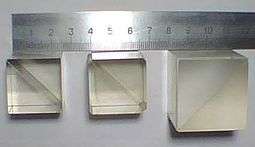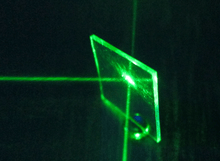Beam splitter
A beam splitter (or beamsplitter[1]) is an optical device that splits a beam of light in two. It is a crucial part of many optical experimental and measurement systems, such as interferometers, also finding widespread application in fibre optic telecommunications.

1 - Incident light
2 - 50% Transmitted light
3 - 50% Reflected light
In practice, the reflective layer absorbs some light.

Beam splitter designs
In its most common form, a cube, it is made from two triangular glass prisms which are glued together at their base using polyester, epoxy, or urethane-based adhesives. The thickness of the resin layer is adjusted such that (for a certain wavelength) half of the light incident through one "port" (i.e., face of the cube) is reflected and the other half is transmitted due to frustrated total internal reflection. Polarizing beam splitters, such as the Wollaston prism, use birefringent materials to split light into two beams of orthogonal polarization states.

Another design is the use of a half-silvered mirror. This is composed of an optical substrate, which is often a sheet of glass or plastic, with a partially transparent thin coating of metal. The thin coating can be aluminium deposited from aluminium vapor using a physical vapor deposition method. The thickness of the deposit is controlled so that part (typically half) of the light which is incident at a 45-degree angle and not absorbed by the coating or substrate material is transmitted, and the remainder is reflected. A very thin half-silvered mirror used in photography is often called a pellicle mirror. To reduce loss of light due to absorption by the reflective coating, so-called "swiss cheese" beam splitter mirrors have been used. Originally, these were sheets of highly polished metal perforated with holes to obtain the desired ratio of reflection to transmission. Later, metal was sputtered onto glass so as to form a discontinuous coating, or small areas of a continuous coating were removed by chemical or mechanical action to produce a very literally "half-silvered" surface.
Instead of a metallic coating, a dichroic optical coating may be used. Depending on its characteristics, the ratio of reflection to transmission will vary as a function of the wavelength of the incident light. Dichroic mirrors are used in some ellipsoidal reflector spotlights to split off unwanted infrared (heat) radiation, and as output couplers in laser construction.
A third version of the beam splitter is a dichroic mirrored prism assembly which uses dichroic optical coatings to divide an incoming light beam into a number of spectrally distinct output beams. Such a device was used in three-pickup-tube color television cameras and the three-strip Technicolor movie camera. It is currently used in modern three-CCD cameras. An optically similar system is used in reverse as a beam-combiner in three-LCD projectors, in which light from three separate monochrome LCD displays is combined into a single full-color image for projection.
Beam splitters with single mode fiber for PON networks use the single mode behavior to split the beam. The splitter is done by physically splicing two fibers "together" as an X.
Arrangements of mirrors or prisms used as camera attachments to photograph stereoscopic image pairs with one lens and one exposure are sometimes called "beam splitters", but that is a misnomer, as they are effectively a pair of periscopes redirecting rays of light which are already non-coincident. In some very uncommon attachments for stereoscopic photography, mirrors or prism blocks similar to beam splitters perform the opposite function, superimposing views of the subject from two different perspectives through color filters to allow the direct production of an anaglyph 3D image, or through rapidly alternating shutters to record sequential field 3D video.
Phase shift
Beam splitters are sometimes used to recombine beams of light, as in a Mach-Zehnder interferometer. In this case there are two incoming beams, and potentially two outgoing beams. But the amplitudes of the two outgoing beams are the sums of the (complex) amplitudes calculated from each of the incoming beams, and it may result that one of the two outgoing beams has amplitude zero. In order for energy to be conserved (see next section), there must be a phase shift in at least one of the outgoing beams. For example, if a polarized light wave in air hits a dielectric surface such as glass, and the electric field of the light wave is in the plane of the surface, then the reflected wave will have a phase shift of π, while the transmitted wave will not have a phase shift. The behavior is dictated by the Fresnel equations.[2] This does not apply to partial reflection by conductive (metallic) coatings, where other phase shifts occur in all paths (reflected and transmitted). In any case, the details of the phase shifts depend on the type and geometry of the beam splitter.
Classical lossless beam splitter
For beam splitters with two incoming beams, using a classical, lossless beam-splitter with electric fields incident at both its inputs, the two output fields Ec and Ed are linearly related to the inputs through
where the 2 × 2 element is the beam-splitter matrix and r and t are the reflectance and transmittance along a particular path through the beam-splitter, that path being indicated by the subscripts. (The values depend on the polarization of the light.)
If the beam-splitter removes no energy from the light beams, the total output energy can be equated with the total input energy, reading
This requirement implies that the beam-splitter matrix is unitary.
Developing the general form of the 2 × 2 unitary matrix. Requiring energy conservation brings about the relationships between reflectance and transmittance
and
where "" indicates the complex conjugate. Expanding, it can be written each r and t as a complex number having an amplitude and phase factor; for instance, . The phase factor accounts for possible shifts in phase of a beam as it reflects or transmits at that surface. Then is obtained
Further simplifying, the relationship becomes
which is true when and the exponential term reduces to -1. Applying this new condition and squaring both sides, it becomes
where substitutions of the form were made. This leads to the result
and similarly,
It follows that .
Having determined the constraints describing a lossless beam-splitter, the initial expression can be rewritten as
Use in experiments
Beam splitters have been used in both thought experiments and real-world experiments in the area of quantum theory and relativity theory and other fields of physics. These include:
- The Fizeau experiment of 1851 to measure the speeds of light in water
- The Michelson-Morley experiment of 1887 to measure the effect of the (hypothetical) luminiferous aether on the speed of light
- The Hammar experiment of 1935 to refute Dayton Miller's claim of a positive result from repetitions of the Michelson-Morley experiment
- The Kennedy-Thorndike experiment of 1932 to test the independence of the speed of light and the velocity of the measuring apparatus
- Bell test experiments (from ca. 1972) to demonstrate consequences of quantum entanglement and exclude local hidden variable theories
- Wheeler's delayed choice experiment of 1978, 1984 etc., to test what makes a photon behave as a wave or a particle and when it happens
- The FELIX experiment (proposed in 2000) to test the Penrose interpretation that quantum superposition depends on space-time curvature
- The Mach–Zehnder interferometer, used in various experiments, including the Elitzur-Vaidman bomb tester involving interaction-free measurement; and in others in the area of quantum computation
Quantum mechanical description
Considering two single mode input fields, denoted by the annihilation operators , which are incident on the two input ports of the beam splitter. The two output fields, denoted by are linearly related to the input field by[4]
In order to obtain the entries of the transformation matrix one must take into account that the commutation relations of the fields' hold. As is well-known from second quantization, one must make sure that
and
This, together with conservation of energy yields the following set of constraints:
For a dielectric 50:50 beam splitter the reflected and transmitted beams differ in phase by . Assuming the reflected beam suffers a phase shift, the input and output fields are related by:
The unitary transformation associated with this transformation is
Using this unitary, one can also write the transforms as
Application for quantum computing
In 2000 Knill, Laflamme and Milburn (KLM protocol) proved that it is possible to create universal quantum computer solely with beam splitters, phase shifters, photodetectors and single photon sources. The states that form a qubit in this protocol are the one-photon states of two modes, i.e. the states |01> and |10> in the occupation number representation (Fock state) of two modes. Using these resources it is possible to implement any single qubit gate and 2-qubit probabilistic gates. The beam splitter is an essential component in this scheme since it is the only one that creates entanglement between the Fock states.
Similar settings exist for continuous-variable quantum information processing. In fact, it is possible to simulate arbitrary Gaussian (Bogoliubov) transformations of a quantum state of light by means of beam splitters, phase shifters and photodetectors, given two-mode squeezed vacuum states are available as a prior resource only (this setting hence shares certain similarities with a Gaussian counterpart of the KLM protocol).[5] The building block of this simulation procedure is the fact that a beam splitter is equivalent to a squeezing transformation under partial time reversal.
References
| Wikimedia Commons has media related to Beam splitters. |
- "Beam Splitters". RP Photonics - Encyclopedia of Laser Physics and Technology. Retrieved 1 March 2019.
- Zetie, K P; Adams, S F; Tocknell, R M, How does a Mach–Zehnder interferometer work? (PDF), retrieved 13 February 2014
- R. Loudon, The quantum theory of light, third edition, Oxford University Press, New York, NY, 2000.
- Knight, Christopher Gerry, Peter (2005). Introductory quantum optics (3. print. ed.). New York: Cambridge University Press. ISBN 052152735X.
- Chakhmakhchyan, Levon; Cerf, Nicolas (2018). "Simulating arbitrary Gaussian circuits with linear optics". Physical Review A. 98: 062314. arXiv:1803.11534. doi:10.1103/PhysRevA.98.062314.